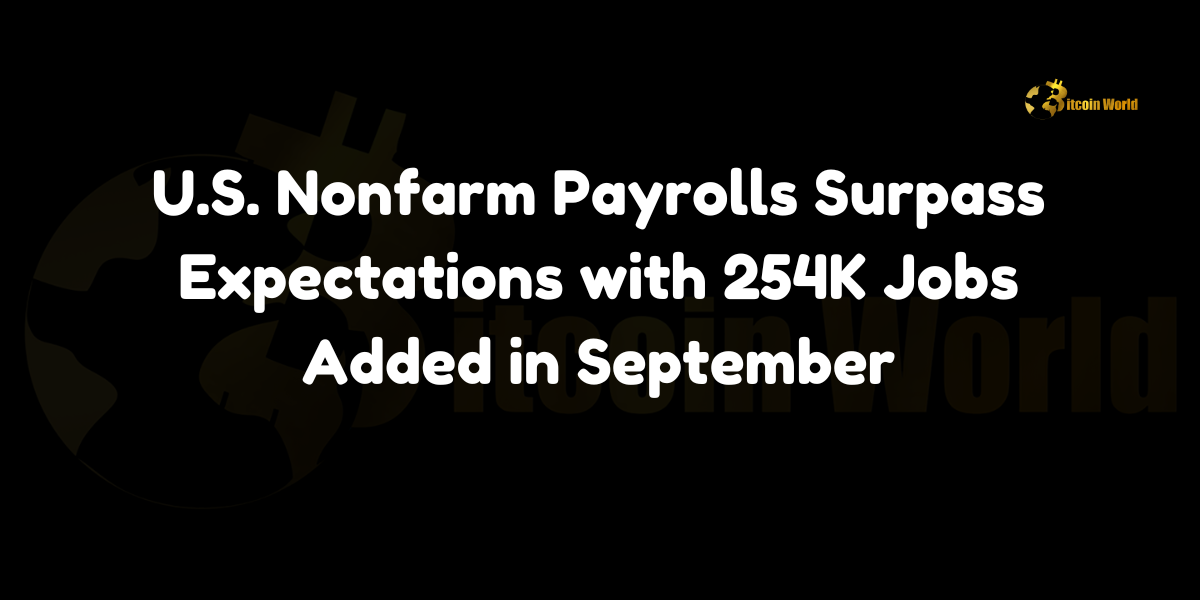US Nonfarm Payrolls Surpass Expectations with 254K Jobs Added in September
The U.S. economy added 254,000 jobs in September, significantly exceeding market expectations of 147,000 jobs, according to data from the U.S. Bureau of Labor Statistics, as reported by Investing.com. The unemployment rate stood at 4.1%, slightly better than the forecasted 4.2%, reflecting continued resilience in the labor market despite ongoing economic challenges.
Strong Job Growth Defies Expectations
The robust increase in nonfarm payrolls signals a positive trend in U.S. employment, indicating that businesses are still hiring at a strong pace. The actual job growth figure substantially outpaced expectations, suggesting that the economy is maintaining momentum even as it faces high inflation, rising interest rates, and geopolitical uncertainties.
This unexpected surge in employment may influence Federal Reserve policy decisions, as stronger-than-expected job growth could support a more aggressive stance on interest rate adjustments in the near term. For policymakers, the job market’s strength could serve as a signal that the economy is capable of withstanding additional measures aimed at curbing inflation.
Key Sectors Driving Job Growth
The latest data reveals that job gains were widespread, with significant contributions from sectors such as healthcare, leisure and hospitality, and professional services. These industries continue to drive job growth as they recover from the disruptions caused by the COVID-19 pandemic and adapt to shifting consumer and business demands.
The healthcare sector added a considerable number of jobs, reflecting ongoing demand for medical services and care workers. Leisure and hospitality also saw notable gains as travel and entertainment activities pick up, despite economic pressures. Professional services, which encompass a range of business-oriented occupations, showed strong hiring as well, indicating that companies are investing in skilled labor to support their operations.
Unemployment Rate Dips to 4.1%
The unemployment rate for September came in at 4.1%, slightly below the anticipated 4.2%. This decline reflects a tightening labor market, with fewer people actively seeking jobs without success. A lower unemployment rate often suggests that employers are more willing to hire, potentially leading to wage growth as competition for talent intensifies.
A continued decrease in the unemployment rate could contribute to wage inflation, as businesses may need to raise salaries to attract and retain employees. This trend could further complicate the Federal Reserve’s efforts to manage inflation, as higher wages often contribute to increased consumer spending, which can drive prices upward.
Potential Implications for Federal Reserve Policy
The unexpected strength in the labor market is likely to factor into the Federal Reserve’s decision-making process on monetary policy. Strong job growth could give the Fed confidence that the economy can absorb additional rate hikes, especially if it views the labor market as overheating.
On the other hand, persistent wage growth and a tight labor market could exacerbate inflationary pressures, prompting the Fed to consider more aggressive measures to bring inflation under control. Investors and analysts will be closely watching upcoming Fed statements and interest rate announcements to gauge how these labor market developments may influence policy directions.
Broader Economic Impact and Market Reactions
The better-than-expected job growth has implications beyond Federal Reserve policy, as it provides a boost to consumer confidence and spending. A strong labor market generally supports economic growth, as more people with jobs tend to lead to higher levels of consumer spending, which is a major driver of the U.S. economy.
In financial markets, the data could lead to fluctuations in stock prices, bond yields, and currency valuations, as investors adjust their expectations in response to the new information. For instance, higher-than-expected job growth might lead to a rise in bond yields, as traders anticipate more interest rate hikes from the Fed.
Conclusion
The addition of 254,000 jobs to U.S. nonfarm payrolls in September reflects a resilient labor market that continues to defy expectations. With the unemployment rate falling to 4.1%, the data suggests ongoing strength in the U.S. economy, which could influence Federal Reserve policy in the coming months.
As the Fed assesses the implications of this robust job growth, businesses and consumers alike will be watching closely to see how monetary policy evolves. For now, the strong labor market provides a measure of optimism amid broader economic challenges, underscoring the importance of job growth in sustaining economic stability.
To learn more about the innovative startups shaping the future of the crypto industry, explore our article on latest news, where we delve into the most promising ventures and their potential to disrupt traditional industries.
Disclaimer: The information provided is not trading advice, Bitcoinworld.co.in holds no liability for any investments made based on the information provided on this page. We strongly recommend independent research and/or consultation with a qualified professional before making any investment decisions.


